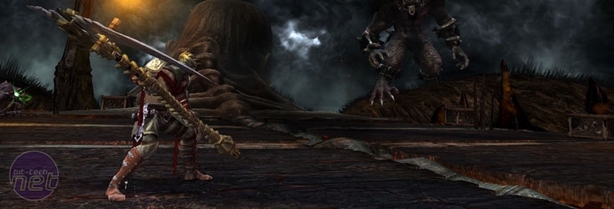
Dis and Dat
On top of the usual combat-centric gameplay though there are few things that help set Dante’s Inferno apart, such as the ability to ride large enemies and beasts, using them to devastate your enemies.We got a chance to try this out on Charon’s back, taking control of a fire-breathing demon before harnessing Charon himself and crashing him into the first circle and...m’eh. It’s basically just a shift in attacks, moving you from the on-foot Dante with his scythe and holy might to a big demon thing that can one-hit-kill most enemies.
In all honesty, what we saw of the beast riding was short-lived and not nearly as thrilling a feature as it was being bigged up to be. It also doesn’t help Inferno’s credibility that the same feature was announced for God of War 3 recently too.
Re-harnessing a modicum of that credibility though is the presence of Virgil in the game as Dante’s guide. In the original work Virgil was Dante’s ever-present guide through Hell and, while his role has been lessened a little, he retains much of the same effect in the game. Rather than being an NPC who’s forever on your heels and in your way, Virgil’s soul can be spotted in various places around Hell and players can interact with him to hear parts of the original work.
Admittedly, as a gameplay feature Virgil doesn’t have much immediate impact as his rhetoric is utterly optional, but adding him in does at least lend context to some of the more unusual design elements that might pass players by. It also helps hammer home just how disturbed Dante must have been to write such epic grotesqueries.
Really though, the main and most important feature of the game isn’t the inclusion of Dante’s original cantos or the beast-riding features; it’s the huge bosses and the cinematic way in which you get to take them down.
We only got to see one boss in our time with Dante’s Inferno; Minos, the judge of all souls whose job it is to place all sinners in one of the lower circles. As blind as any other form of justice, Minos refuses the still-alive Dante further progress into Hell and the pair enter into a rather epic battle that sees the hero scaling classical Greek columns before literally splitting the judge’s skull after a quick QTE.
All very thrilling and undeniably satisfying in that old-school sense, it was impossible not to like the boss battle with Minos. The feeling of accomplishment and pleasure that comes from learning attack patterns and successfully slaughtering a foe after five or six failed attempts is what games like Dante’s Inferno really excel at. It’s something that Dante’s Inferno does a lot better than most other games in the genre too as, if Minos is anything to go by, then the pivotal boss fights will remain taxing without ever becoming unfair or too much of a grind.
Our final impressions of the game however were ultimately very mixed. There’s no denying that Dante’s Inferno appeared a solidly named game, with responsive controls, fantastic graphics and a presentation that is at least consistent within itself, but somehow we were left underwhelmed. On the lower-level it’s perhaps because the game is so massively derivative that it’s hard to see a single unique feature within it, making the experience practically indistinguishable from other games in the genre. Not a bad thing if all you want is just more of the same, but the potential is there for so much more.
With that in mind, we get quickly lead on to our second complaint which is the somewhat snobbish disappointment in the way that the source material has been adapted. Dante’s Inferno isn’t a bad game by any means, but we honestly question the value of attaching it to the franchise as all it does is attract cynicism and raise expectations. The reality is that the game would be just as good, probably better, without the Alighieri connection and the Dante prefix. With the connection established though it’s almost impossible to judge the game solely on its own merits as the supposed source material is constantly present.
Regardless of whether it’s better as Dante’s Inferno or simply Inferno though, the fact remains that the game struggled to rise above being run of the mill, mainly because there’s nothing here that hasn’t been done before.
Dante’s Inferno is to be published on the PC, PS3 and Xbox 360 by Electronic Arts in 2010.

MSI MPG Velox 100R Chassis Review
October 14 2021 | 15:04











Want to comment? Please log in.